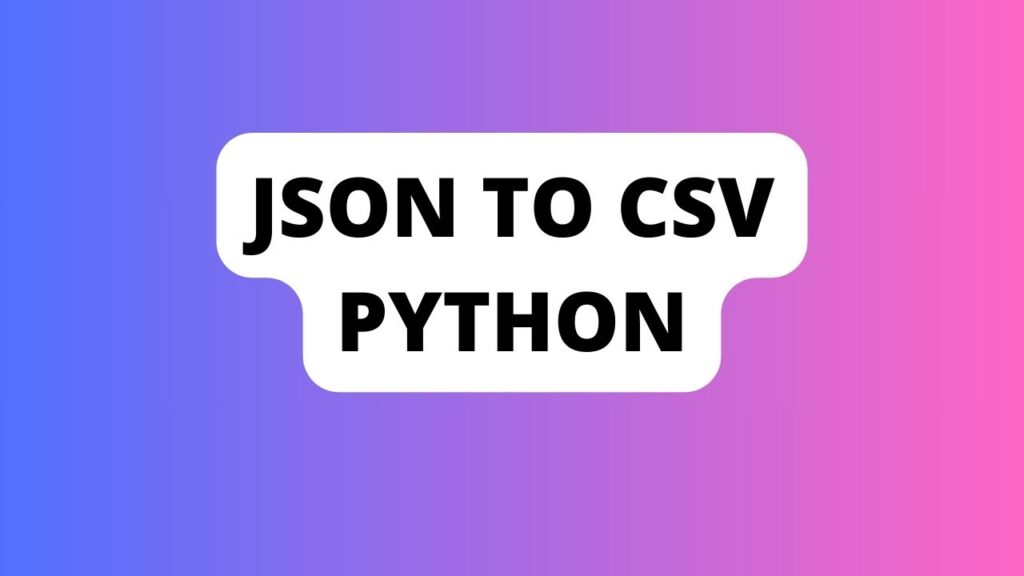JSON to CSV Python: Simplifying Data Transformation
Json to Csv Python The world of data handling and transformation has been revolutionized by Python’s flexibility and powerful libraries. When it comes to converting data from JSON (JavaScript Object Notation) to CSV (Comma-Separated Values), Python offers a myriad of solutions. In this article, we’ll dive deep into this transformation, uncovering the nuances, techniques, and best practices.
Introduction
What is JSON to CSV conversion in Python? JSON and CSV represent two popular formats for storing and transmitting data. JSON, known for its hierarchical structure, is widely used for API responses and configuration files. On the other hand, CSV, with its tabular form, is ideal for storing large datasets. Converting JSON to CSV in Python involves transforming the nested JSON structure into a flat CSV format, simplifying data analysis and manipulation.
JSON Basics
Understanding JSON format JSON employs a key-value pair structure, allowing flexibility in data representation. Its nested nature permits complex data hierarchies, making it a common choice for APIs and configuration files. Each JSON file contains objects enclosed within curly braces {}, arrays within square brackets [], and key-value pairs separated by colons :.
CSV Basics
Understanding CSV format CSV, a simpler data format, represents tabular data using commas , as separators. Each line in a CSV file represents a row, and commas delineate individual columns. CSV lacks the hierarchy present in JSON but offers a straightforward layout for easy readability and manipulation.
Python Libraries for JSON to CSV Conversion
Python provides powerful libraries like Pandas, offering efficient methods for handling data conversions.
Step-by-Step Guide: Converting JSON to CSV
Installing necessary libraries
To initiate the conversion process, ensure you have the required Python libraries installed.
Loading and reading JSON files
Utilize Python’s functionalities to load and read JSON files into your workspace.
Converting JSON to CSV
Leverage Pandas or other Python libraries to seamlessly convert the JSON data structure to CSV.
Best Practices for Efficient Conversion
Data cleaning before conversion Prioritize cleaning the data to ensure accuracy and consistency in the resulting CSV file.
Error Handling
Common errors and their solutions Address common errors encountered during conversion, providing effective solutions.
Converting Json to Csv Using Python
– Importing Necessary Libraries
To initiate the conversion process, importing the relevant Python libraries—such as Pandas and Json—sets the foundation.

– Loading Json Data
Understanding how to load Json data into Python is crucial. This step involves accessing and preparing the Json data for conversion.
– Converting Json to Csv
The pivotal process of transformation involves Python functions and methods to convert Json to Csv seamlessly.
– Handling Data Transformation Errors
Addressing potential errors during the transformation ensures a smoother conversion process. Strategies to handle errors effectively are detailed here.
Best Practices for Efficient Conversion
– Data Cleaning Tips
Optimizing data integrity through cleaning techniques improves the quality of Csv output.
– Handling Nested Json Structures
Dealing with complex nested Json structures requires specialized approaches for accurate conversion.
– Performance Optimization
Techniques to enhance performance, especially with large datasets, streamline the conversion process.
Performance Optimization
Enhancing conversion speed Explore techniques to optimize the conversion process for efficiency.
Applications and Use Cases
Real-life scenarios for JSON to CSV conversion Discover practical applications of this transformation across industries and domains.
FAQs
How does JSON differ from CSV? JSON allows nested structures, while CSV represents tabular data without hierarchies.
Is it possible to convert nested JSON to CSV directly? Yes, Python libraries like Pandas offer methods to flatten and convert nested JSON to CSV.
What are the advantages of using Python for conversion? Python’s libraries provide efficient tools, simplifying complex data transformations.
How to deal with large JSON files during conversion? Optimize memory usage and consider processing chunks of data at a time.
Are there limitations in converting JSON to CSV? Limitations may arise with complex nested structures; however, Python offers solutions.
Any recommended resources for further learning? Explore online tutorials, documentation, and practical exercises for hands-on learning.
Conclusion
In summary, Python’s prowess in handling data shines through its ability to seamlessly convert JSON to CSV. With its rich libraries and versatile functionalities, Python simplifies what was once a complex transformation, opening doors to diverse data manipulation possibilities.
